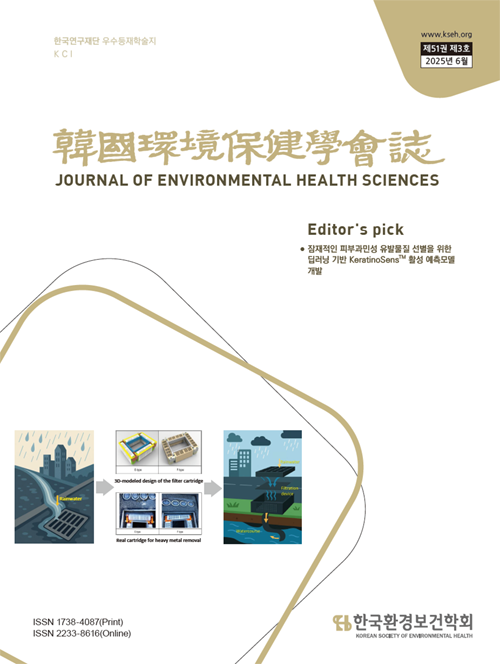- 영문명
- 국내 실내공기 중 생물학적Characteristics of Exposure to Biological Agents (Bacteria, Fungi) in Indoor Air in South Korea 유해인자(세균, 진균) 노출 특성
- 발행기관
- 한국환경보건학회
- 저자명
- 유민서(Minseo Yu) 김애진(Aejin Kim) 이윤지(Yun Ji Lee) 이다영(Dayeong Lee) 안서진(Seojin An) 정지연(Jee Yeon Jeong) 황성호(Sung Ho Hwang)
- 간행물 정보
- 『한국환경보건학회지』제51권 제3호, 129~136쪽, 전체 8쪽
- 주제분류
- 공학 > 환경공학
- 파일형태
- 발행일자
- 2025.06.30
4,000원
구매일시로부터 72시간 이내에 다운로드 가능합니다.
이 학술논문 정보는 (주)교보문고와 각 발행기관 사이에 저작물 이용 계약이 체결된 것으로, 교보문고를 통해 제공되고 있습니다.

국문 초록
Background: Currently, there are no comparative studies of differences in concentrations of biological agents (airborne bacteria and fungi) in various indoor environments reported in domestic South Korean journals.
Objectives: To identify the characteristics of exposure concentrations in the indoor environment by analyzing studies on airborne bacteria and fungi from biological factors published in domestic journals.
Methods: A total of 239 articles were retrieved using the Korean Studies Information Service System (KISS), and 20 employing the impactor sampling method were ultimately selected. Among the various sampling techniques, impactor sampling was chosen due to its widespread use in domestic studies and for its ability to provide standardized, culture-based concentration data (CFU/m3) that enables reliable comparison across different indoor environments. Among these studies, 13 addressed airborne bacteria and ten addressed airborne fungi. To compare concentration levels across different types of indoor environments, non- parametric statistical analyses, including the Kruskal-Wallis test, were performed using R and SPSS.
Results: According to the comparison of bacterial concentrations by indoor environment type, the average bacterial concentration showed a statistically significant difference depending on the classification of indoor environments (p<0.01). Occupational environments, particularly organic waste resource facilities, showed the highest mean bacterial concentration at 4,126.8 CFU/m3, exceeding the South Korean indoor air quality guideline of 800 CFU/m3.
Conclusions: These findings provide an overview of the concentration levels of airborne bacteria and fungi in various indoor environments in South Korea and may serve as a foundational reference for establishing indoor air quality management policies.
영문 초록
목차
Ⅰ. 서 론
Ⅱ. 방 법
Ⅲ. 결과 및 고찰
Ⅳ. 결 론
References
해당간행물 수록 논문
- [Editorial] 기후변화, 환경을 넘어 건강 위기로 … 환경보건 대응이 시급하다
- 한국환경보건학회지 제51권 제3호 목차
- 감염병 위기에서 AI는 어떻게 사용되었는가: COVID-19 연구동향 분석
- 도로 유출수 내 중금속 제거를 위한 카트리지형 나노영가철 필터 개발 및 평가
- 잠재적인 피부과민성 유발물질 선별을 위한 딥러닝 기반 KeratinoSens™ 활성 예측모델 개발
- 최근 신축된 국내 공동주택의 실내 라돈 농도: 지역, 계절, 건축 특성 및 정책 기준에 따른 영향 분석
- 국내 실내공기 중 생물학적 유해인자(세균, 진균) 노출 특성
- 도금폐수 내 중금속 침전 제거 및 슬러지 감량에 관한 연구
참고문헌
교보eBook 첫 방문을 환영 합니다!

신규가입 혜택 지급이 완료 되었습니다.
바로 사용 가능한 교보e캐시 1,000원 (유효기간 7일)
지금 바로 교보eBook의 다양한 콘텐츠를 이용해 보세요!



